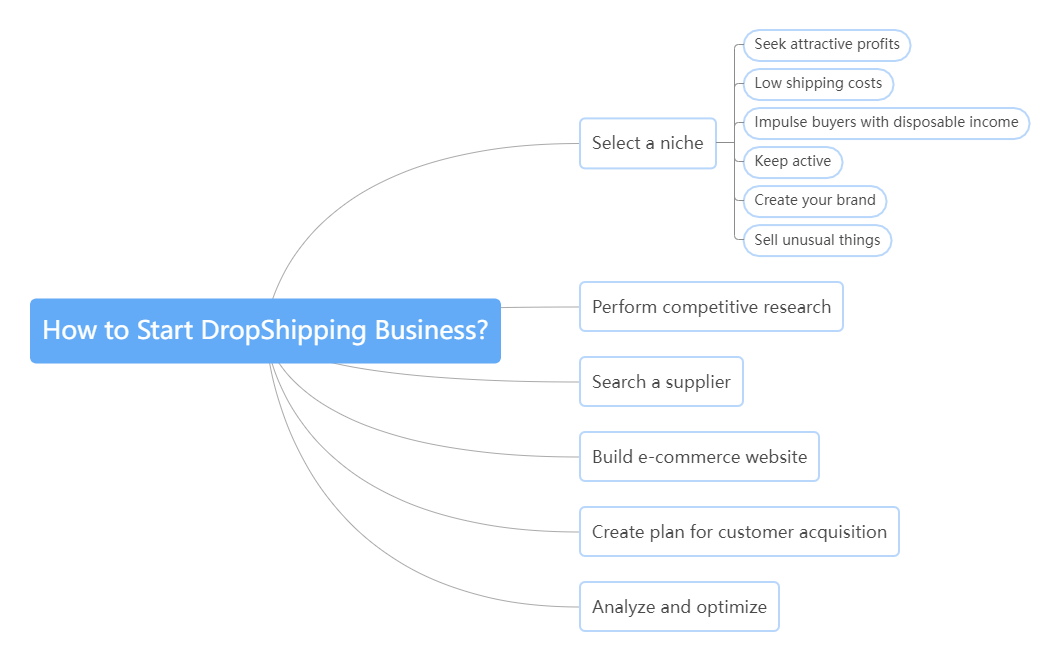How to Start a Dropshipping Business?
Dropshipping is a very popular business model for new entrepreneurs, especially Gen Xers and millennials. Not only does it not require much initial capital, which reduces operating costs; it also saves you time. So you can focus on acquiring customers, saving inventory and handling whatever you sell.
You can buy products from third-party suppliers and manufacturers, apply a dropshipping model on an e-commerce site when selling the products, and then process the order. You can follow the steps below to start a dropshipping business.

1. Pick a Niche
The chosen niche should grab the public's attention and interest you. Otherwise, it will be difficult to open the market. It can be easy for you to get discouraged because there is a lot of work that needs to be done before you can successfully scale your dropshipping business.
Here are a few points:
(1) Seek attractive profits
Choose a niche with valuable products. Whether you're selling a $20 item or a $1,500 item, the amount of work required is basically the same. You just need to focus on marketing and customer acquisition when running your store.
(2) Lower transportation cost
Use international logistics and transportation channels with lower shipping costs to reduce operating costs to generate further sales. If shipping is too high, it can put your customers off.
(3) Commodity prices that stimulate buyers
While focusing on getting attention to your website, you need to make sure that the price of what you sell should also get their attention.
(4) Stay active
Use Google's Keyword Planner and Trends to check some common search terms and make them relevant to your potential niche.
(5) Create your brand
Your dropshipping business will be more valuable if you can rebrand. You can label the products of your choice with custom packaging and branding.
(6) Selling something special
Look to showcase what your customers won't find on the street. This way, you will be more attractive to potential customers.
2. Conduct competitive research
Remember, you'll be competing with other drop shipping carriers as well as retail giants like Walmart and Amazon. There is a common misconception that most people are looking for products without competition. This means there is no demand.
There are many reasons why a product might not have much competition, such as high shipping costs, poor suppliers, manufacturing issues, or low profit margins. Look for competitive products. This shows that demand is high and the business model is sustainable.
3. Find suppliers
Working with the wrong supplier can ruin your business. So please don't rush. Conduct due diligence. Most dropshipping suppliers are overseas. So communication is extremely important for reaction speed and mutual understanding. If you're not 100% confident in them, keep looking.
People are using Aliexpress and eBay. But their dropshipping suppliers have had a lot of trouble with the platform. So most of them are turning to other platforms like AliPrice Dropshipping.
Try to learn from the past paths of other entrepreneurs. There are many sources of information available, from business, technology, blogs, to this section on dropshipping. This is a hot topic that can help you avoid the mistakes of working with costly suppliers.
4. Build an e-commerce website
The fastest way to start a website is to use simple e-commerce platforms such as Shopify and WooCommerce in the US and other countries; Naver and Coupang in Korea; also available on Etsy, eBay, WED2C, and more. They support the dropshipping business model. You don't need a technical background to get up and running. And there are plenty of apps that can help you increase your sales.
Even if you have a large budget to hire a web design and development company to create a custom solution, it is wiser to use a plug-and-play option, especially when starting out. Once you're in the initial stages and you start earning money, you can explore other customizations for your website.
5. Develop a customer acquisition plan
Got a great product and the website is great. But if no customers want to buy, you're not really a company. There are many ways to attract potential customers. However, launching a Facebook ad campaign is one of the most successful options.
This enables you to bring in sales and revenue from the start. It can lead to rapid expansion. Facebook lets you show your products directly to a highly targeted audience. This will give you the opportunity to compete with the biggest brands and retailers in no time. If you don't know how to start an ad campaign on Facebook, sites like WED2C allow you to share their products directly.
You have to think long term and you can also focus on SEO and email marketing. From the start, collect emails and set up automated email sequences offering discounts and special offers. It's an easy way to leverage your existing customer base and generate revenue without additional advertising and marketing spend.
6. Analysis and optimization
You need to track all the data and metrics you can use to grow your business. This includes traffic from Google Analytics and conversion pixel data from Facebook (if this is your primary channel for acquiring customers). By monitoring every conversion—understanding where customers are coming from and where their behavior on your site ultimately leads to the transaction—you can expand what works and remove what doesn’t.
Keep looking for new opportunities and fine-tuning your current campaigns so you know when to optimize or move them.